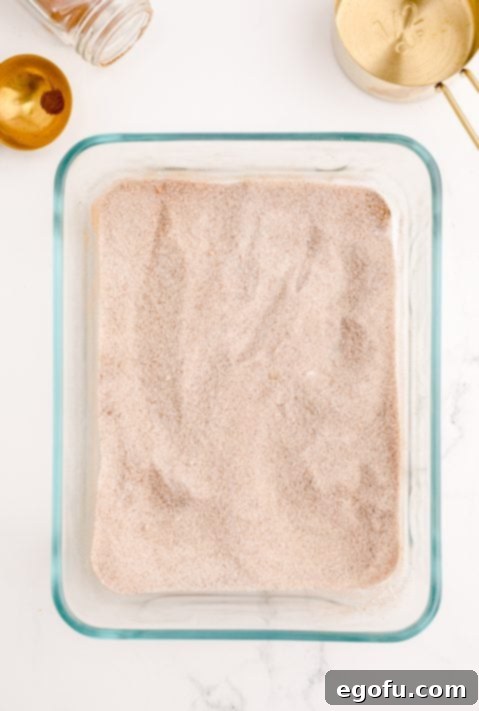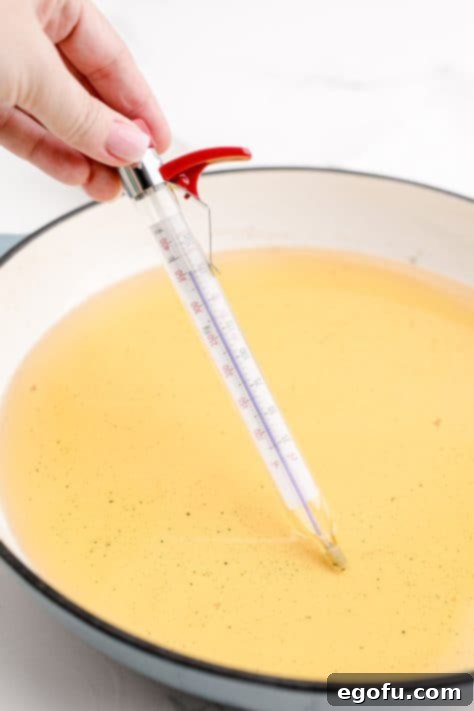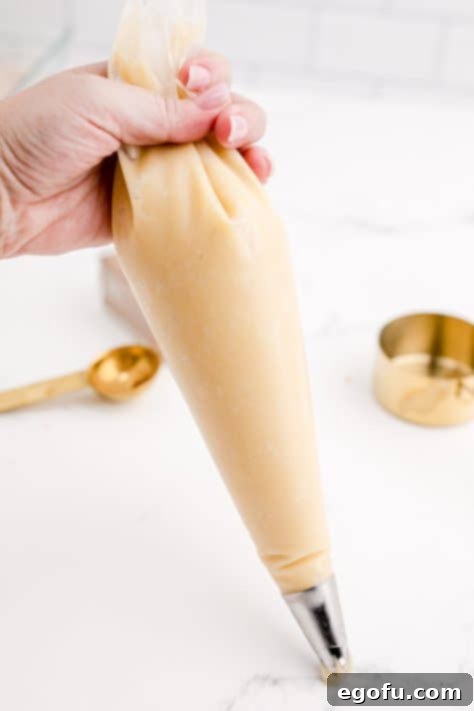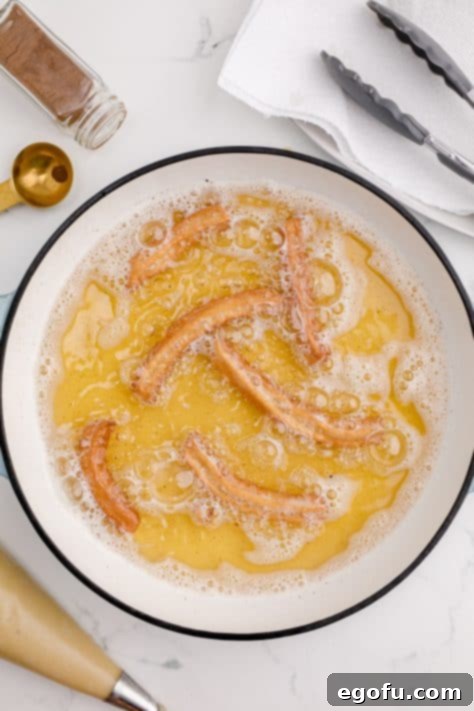Homemade Churros: Your Ultimate Guide to Crafting Perfect Fried Dough Pastries
There’s something uniquely magical about churros – those golden, crispy, cinnamon-sugar coated delights that bring joy with every bite. Often associated with festive fairs, vibrant street vendors, and the nostalgic enchantment of places like Disneyland, churros are a beloved treat enjoyed worldwide. But what if you could recreate that magic in your own kitchen? This comprehensive guide will walk you through everything you need to know to make the most delicious homemade churros, transforming your home into a personal Mexican bakery.
Why Homemade Churros Are a Must-Try
Imagine biting into a warm, freshly fried churro, the delightful crunch of the cinnamon-sugar exterior giving way to a soft, tender interior. This unparalleled experience is precisely what homemade churros offer. While theme park churros hold a special place in our hearts, making them from scratch guarantees peak freshness and flavor that store-bought or even many restaurant versions can’t match. Plus, the process itself is a fun and rewarding culinary adventure perfect for family activities or treating yourself to a delightful dessert.
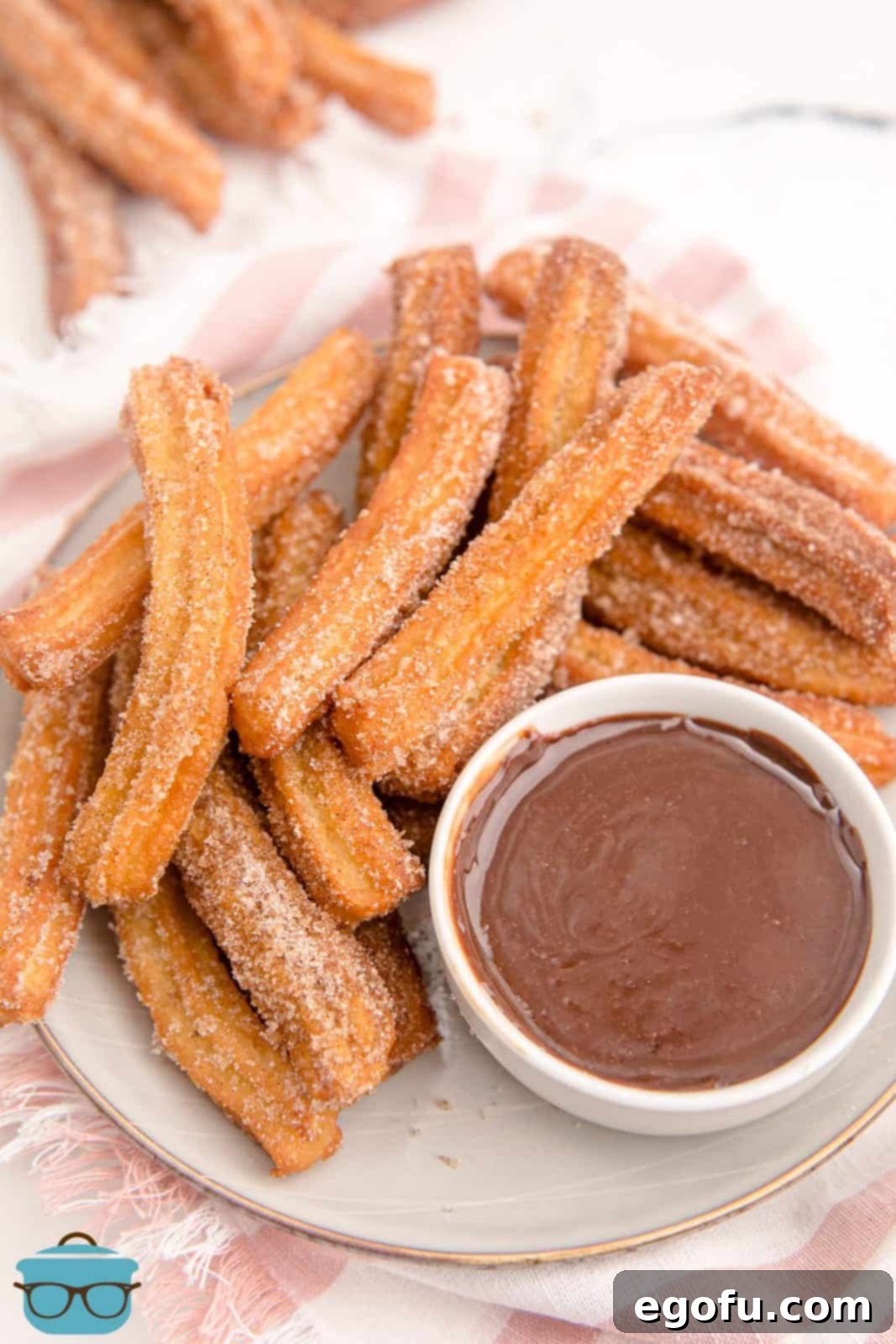
Essential Ingredients for Authentic Churros
Creating perfect churros begins with a few simple, everyday ingredients. The beauty of this recipe lies in its accessible nature, allowing anyone to whip up a batch of these irresistible treats.
- Water: The base for our choux pastry. Room temperature water is ideal for a smooth dough consistency.
- Granulated Sugar: Used in both the churro batter and, crucially, for the iconic cinnamon-sugar coating. Its fine texture ensures it melts beautifully into the hot churros, creating that signature sweet crunch.
- Salted Butter: Contributes richness and flavor to the dough. While it might seem like “salt overkill” when combined with additional salt, trust that it balances the sweetness and enhances the overall taste profile.
- Vanilla Extract: A fragrant addition that elevates the churro’s flavor. Feel free to experiment with other extracts like almond or coconut for a unique twist, though classic vanilla remains a favorite.
- All-Purpose Flour: The structural component of the dough. It’s vital to use all-purpose flour, not self-rising, as we need precise control over the dough’s leavening process.
- Egg: An indispensable ingredient that binds the choux pastry together and helps it puff up during frying. For best results and easier incorporation, allow your egg to reach room temperature before mixing.
- Cinnamon: The star of the churro coating! Classic ground cinnamon, combined with sugar, creates the quintessential churro experience.
- Vegetable Oil for Frying: Essential for deep-frying the churros to a perfect golden crisp. Choose an oil with a high smoke point for best results.
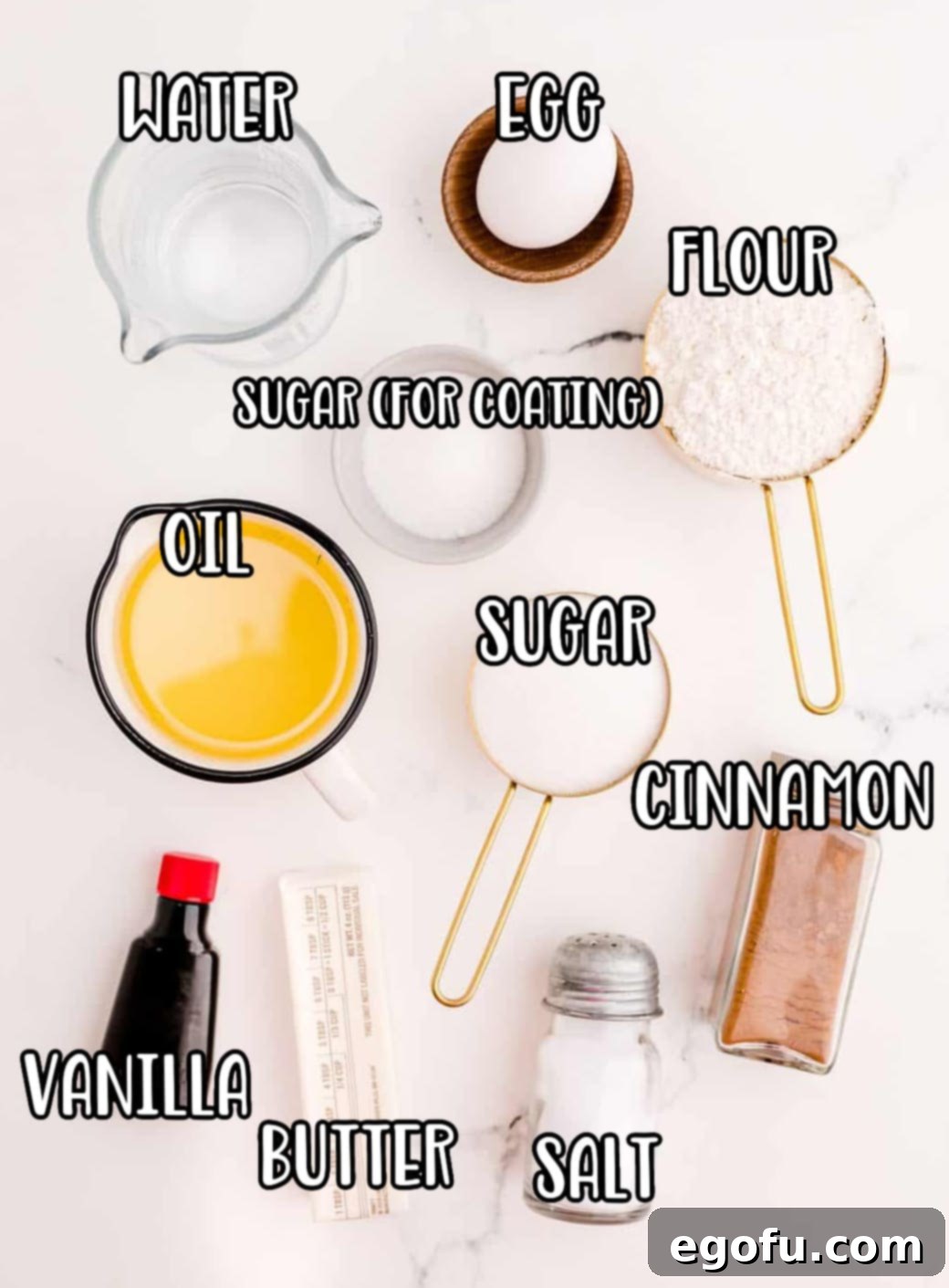
Frequently Asked Questions About Making Churros
For deep-frying churros, you need an oil with a high smoke point that can withstand high temperatures without breaking down or imparting undesirable flavors. Excellent choices include peanut oil, soybean oil, corn oil, and sunflower oil. These oils will ensure your churros fry evenly and develop that beautiful golden-brown color and crispy texture.
Churros are made from a type of pastry dough known as choux pastry (pronounced “shoo”). This unique dough is cooked on the stovetop before being piped and fried. Its distinctive characteristic is its ability to puff up significantly when exposed to heat, creating a hollow interior and a light, airy texture that is perfectly complemented by a crispy exterior. This cooked dough ensures a stable structure for frying.
Yes, eggs are an absolutely essential ingredient in churro dough! They act as a crucial binding agent, bringing all the ingredients together and adding richness. More importantly, the egg helps create the steam necessary for the choux pastry to puff up during frying, contributing to the churro’s signature light and airy interior. Remember to only mix the egg into the dough once it has cooled slightly; adding it to hot dough will cause the egg to scramble.
The most common reason for non-crispy churros is incorrect oil temperature. If the oil isn’t hot enough (below 350°F or 175°C) when you pipe the dough in, the churros will absorb too much oil and become greasy and soggy instead of crisp. Conversely, if the oil is too hot, the outside will burn before the inside cooks through. Using a cooking thermometer to maintain a consistent oil temperature of 350-360°F (175-180°C) is crucial for achieving that perfect crispy exterior.
The ideal churro offers a delightful textural contrast: a satisfyingly crunchy and golden-brown exterior, perfectly coated in cinnamon sugar, followed by a soft, tender, and somewhat airy interior. They should never be completely hard or chewy throughout, nor should they be entirely soft or doughy. Achieving this balance is the hallmark of a well-made churro.
Churros are incredibly versatile and delicious on their own, but they truly shine when paired with dipping sauces. Our favorites include a rich homemade chocolate sauce or a luscious caramel sauce. My Salted Caramel Sauce is a fantastic match! Other popular options include dulce de leche, fruit sauces, or simply extra granulated sugar for dusting. A scoop of vanilla ice cream can also be a wonderful accompaniment.
Churros that are raw or gooey in the middle are usually a sign that your frying oil was too hot. When the oil is excessively hot (above 360°F or 180°C), the outside of the churro cooks and browns very quickly, forming a crust that prevents the heat from penetrating and cooking the inside thoroughly. To prevent this, always use an oil thermometer to maintain a consistent temperature, and avoid piping overly large pieces of dough, which take longer to cook through.
Churros are best enjoyed fresh, but leftovers can be stored. Place cooled churros in an airtight container lined with paper towels at room temperature, where they will keep for up to 2 days. Avoid storing them in the refrigerator, as this can make them soggy. For longer storage, freeze cooled churros in a freezer bag for up to 1 month. To defrost, transfer them to the refrigerator overnight. To reheat and regain some crispness, bake them in a preheated oven at 350°F (175°C) for about 10 minutes, or pop them into an air fryer for a few minutes until warmed through and crispy.
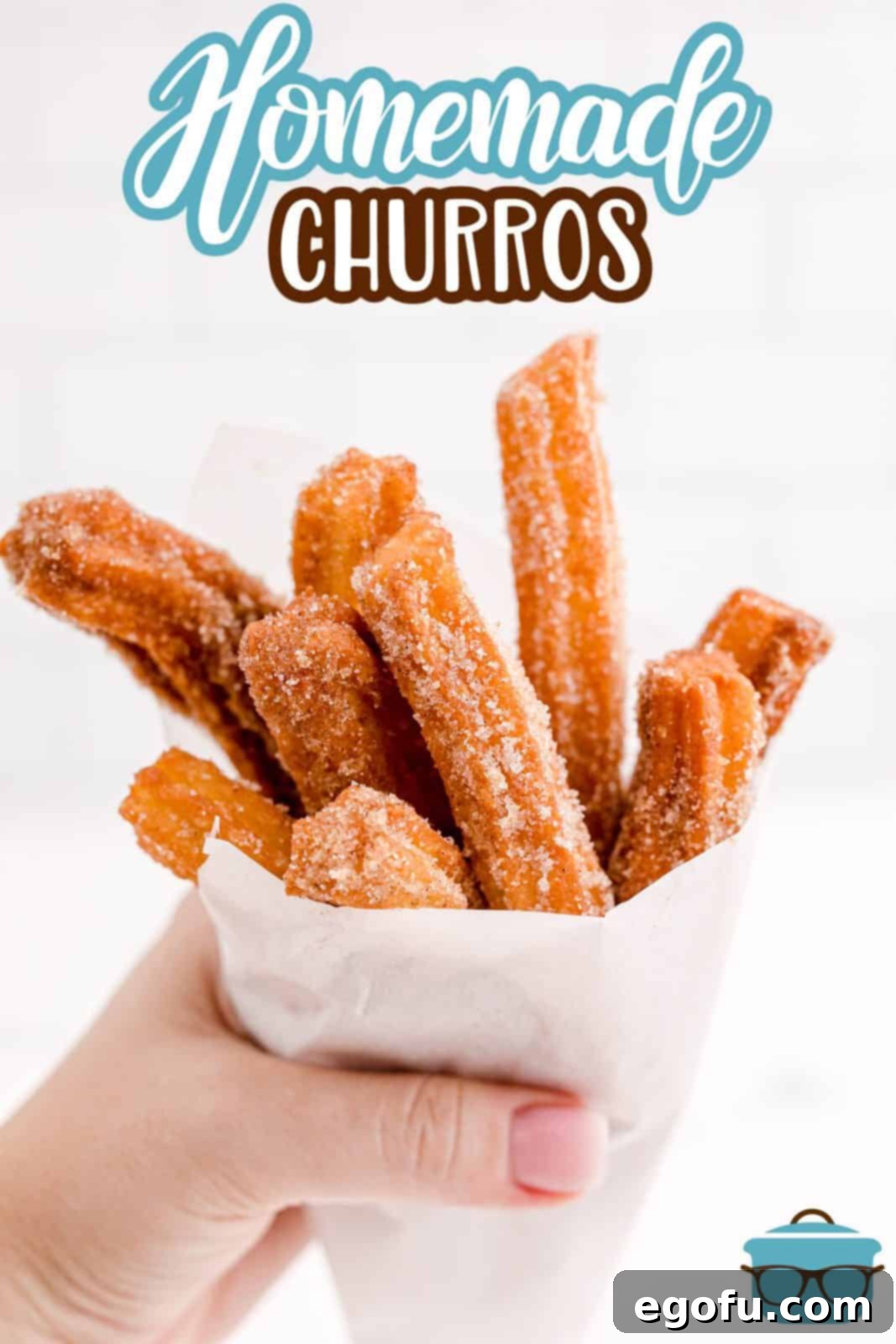
Step-by-Step: Mastering Homemade Churros
Making churros might seem intimidating, but with clear instructions and a little practice, you’ll be piping perfectly golden, crispy churros in no time. Follow these detailed steps for churro perfection:
1. Preparing the Cinnamon Sugar Coating
In a medium-sized casserole dish or a shallow bowl, whisk together ½ cup of granulated sugar and 1 Tablespoon of ground cinnamon. Make sure the sugar and cinnamon are thoroughly combined. This mixture will be used to coat your churros immediately after frying, so set it aside where it will be easily accessible.
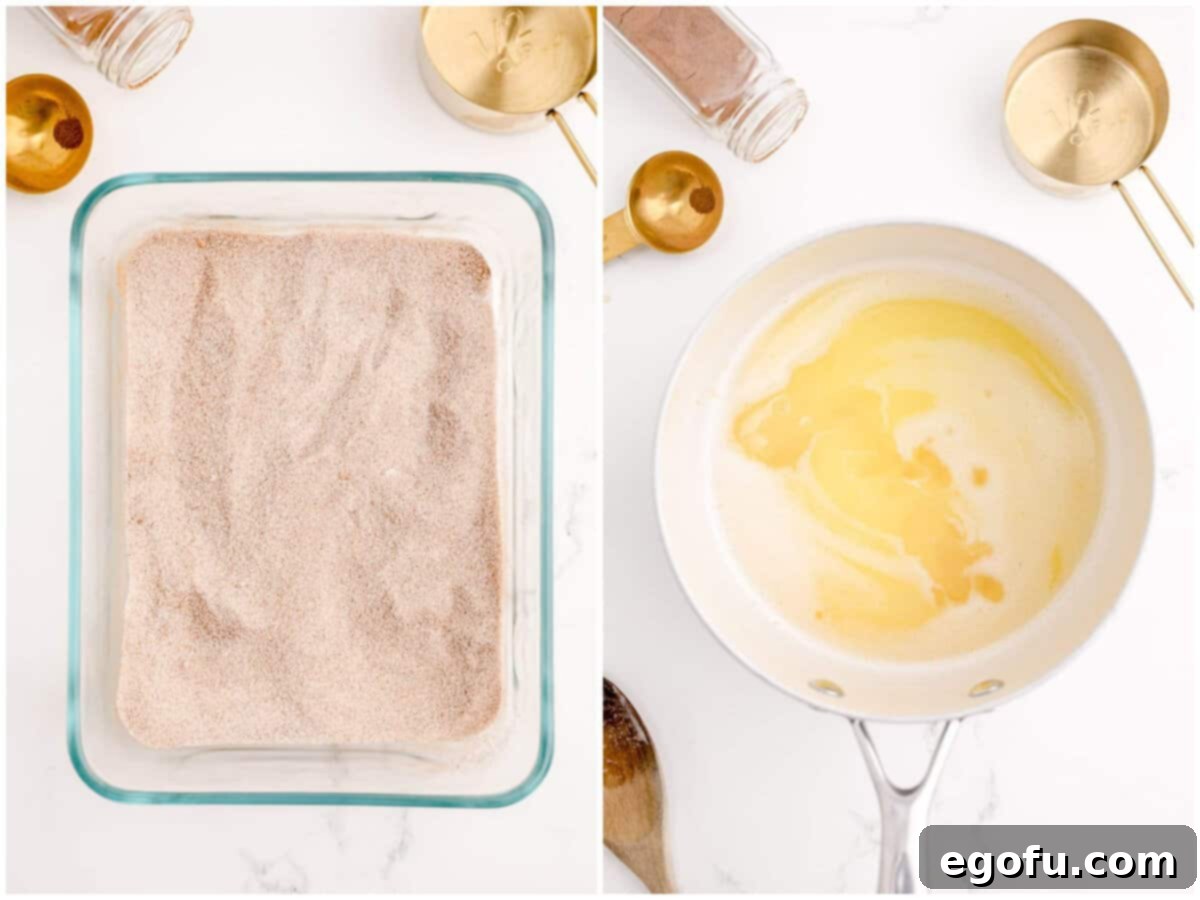
2. Crafting the Choux Pastry Dough
To begin the dough: combine 1 cup of water, 2 Tablespoons of granulated sugar, ½ teaspoon of salt, and 5 Tablespoons of salted butter in a large saucepan. Place the saucepan over medium-high heat and bring the mixture to a full rolling boil. Once boiling, immediately remove the saucepan from the heat and stir in 1 teaspoon of vanilla extract.
Next, add 1 cup of all-purpose flour to the hot mixture. Stir vigorously for about a minute using a wooden spoon or heat-resistant spatula until the mixture becomes smooth and thick, forming a cohesive ball that pulls away cleanly from the sides of the pan. The dough should resemble a thick paste or even play-doh. Transfer this thickened batter into a large mixing bowl and allow it to cool for at least 10 minutes. This cooling step is critical before adding the egg.
While the dough cools, prepare your frying station. Pour 4-6 cups of vegetable oil (or your preferred high-smoke-point oil) into a large, heavy-bottomed pot or Dutch oven, ensuring the oil is about 2 inches deep. Begin heating the oil over medium heat. It’s highly recommended to use a candy thermometer to monitor the oil temperature, aiming for a consistent 350-360°F (175-180°C). This temperature control is vital for evenly cooked churros. As the oil heats, place a plate lined with paper towels next to the pot for draining the fried churros.
Once your churro batter has cooled sufficiently (it should be warm to the touch but not hot), add the single egg. Immediately begin beating the egg into the batter with a hand mixer until it is thoroughly combined and smooth. Beating quickly from the moment the egg is added prevents it from cooking prematurely in the warm dough.
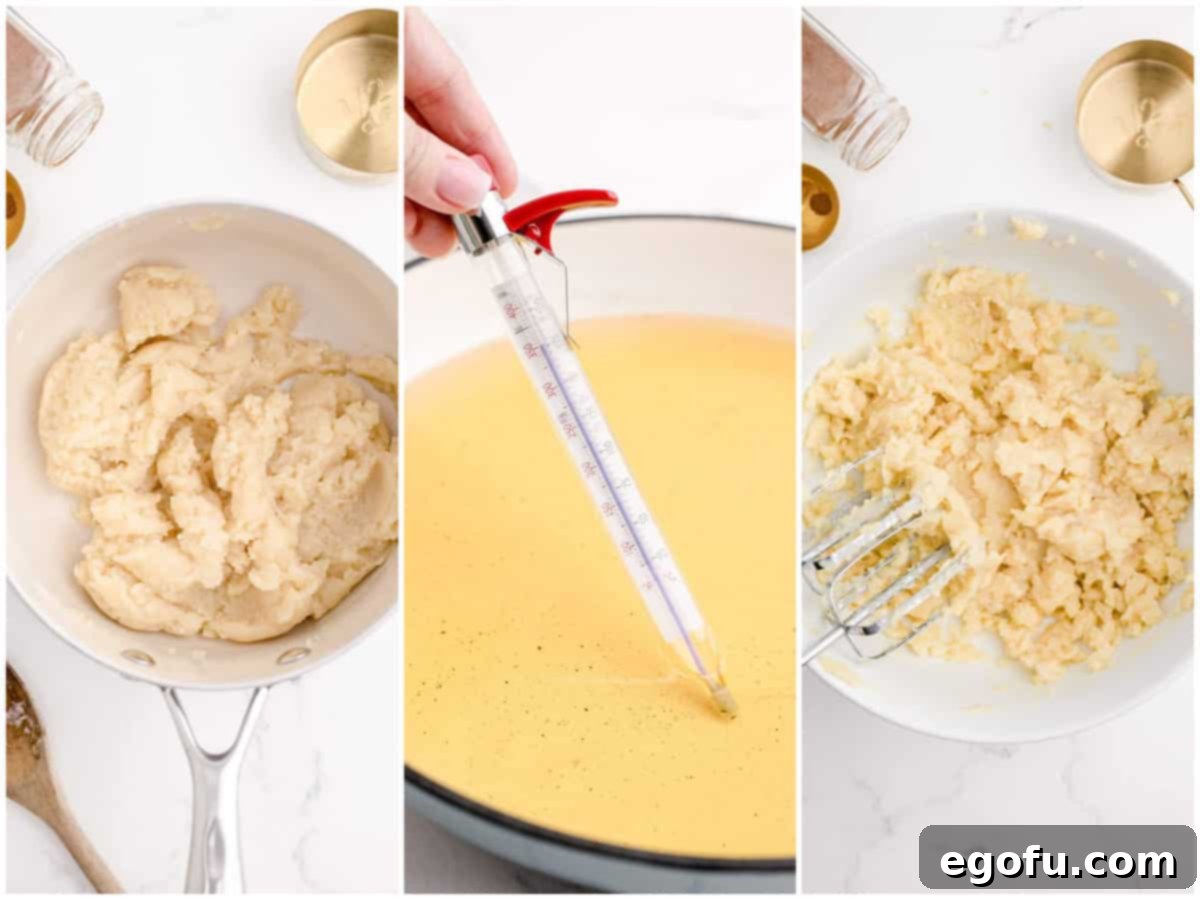
3. Frying Your Churros to Golden Perfection
Now for the fun part! Transfer the thick churro dough into a sturdy piping bag fitted with a large star or flower tip (e.g., Wilton 1M or similar). Important Tip: This batter is exceptionally thick, almost like play-doh. A thin, disposable plastic baggie will likely burst under pressure. Invest in a reusable silicone piping bag or a heavy-duty canvas bag for the best results. I speak from experience – learning this the hard way is no fun!
Carefully pipe 4-5 inch long ropes of churro dough directly into the hot oil. Use kitchen scissors to snip the dough cleanly from the piping tip. Work in batches, frying only a few churros at a time to avoid overcrowding the pot, which can lower the oil temperature and lead to soggy churros. Having a second person to help – one to pipe, one to cut – can make this step much easier and more efficient.
Fry the churros for about 5 minutes, or until they are deeply golden brown and cooked through. They will initially sink slightly then float to the surface. After about 2.5 minutes, use tongs to gently turn them over, ensuring both sides cook evenly and achieve a uniform golden hue.
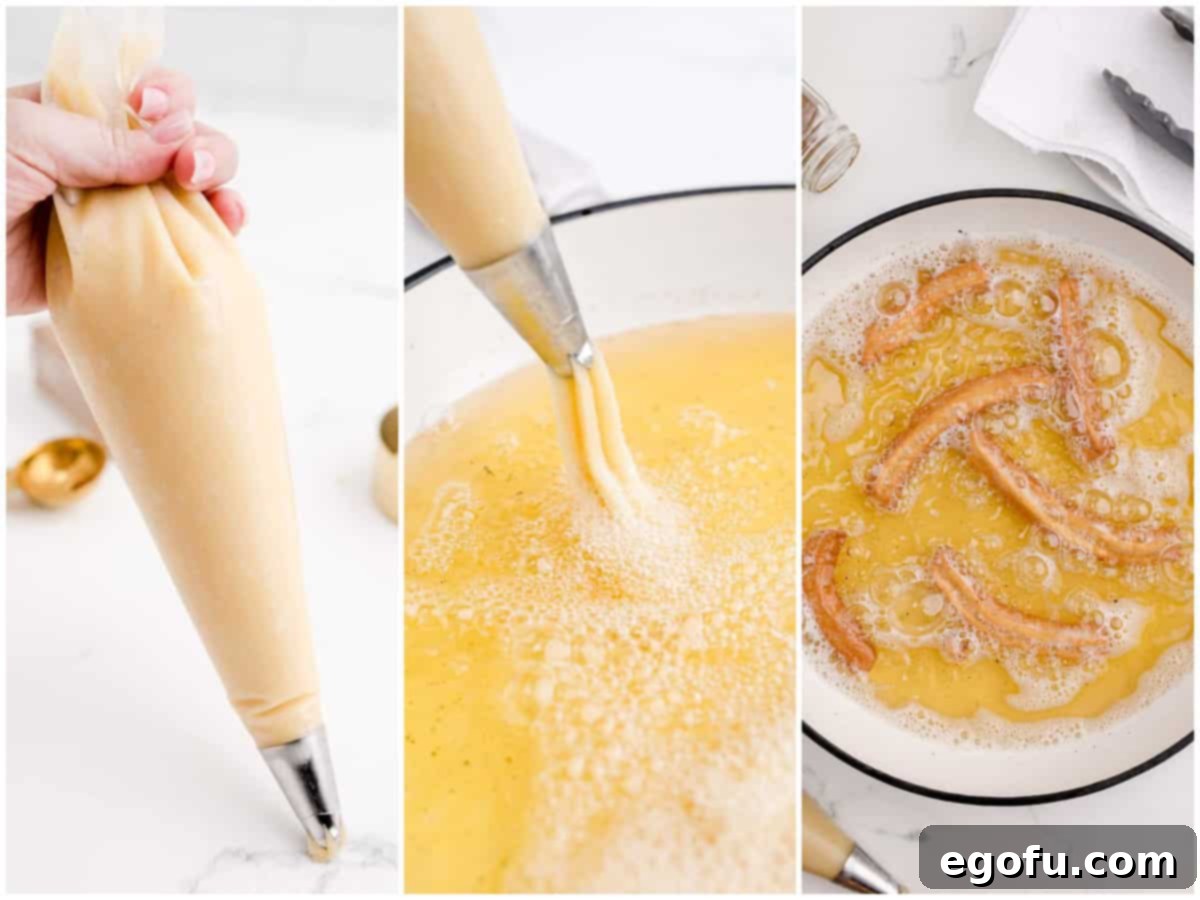
4. Coating and Serving Your Delicious Churros
As each batch of churros finishes frying, remove them from the oil using tongs or a slotted spoon and immediately place them on the paper towel-lined plate to drain any excess oil. Working quickly is key here: while still hot and moist from the oil, transfer the churros directly into the cinnamon-sugar mixture you prepared earlier. Toss them gently but thoroughly to ensure they are fully coated. The heat and slight stickiness of the churro will help the sugar adhere perfectly, creating that irresistible sweet and spicy crust. Once coated, place them on a cooling rack to prevent them from becoming soggy.
Repeat the frying and coating process with the remaining dough until all your churros are cooked. Serve them immediately while they are still warm for the best experience. The crunchy exterior and tender interior, infused with cinnamon and sugar, are truly a delight!

Tips for Success & Troubleshooting
Achieving churro perfection is within reach with a few extra tips and tricks:
Piping Bag Wisdom
As mentioned in the instructions, the consistency of churro dough is very thick. It’s more like a play-doh or stiff cookie dough than a cake batter. Using a flimsy piping bag will almost certainly result in a messy burst. Invest in a heavy-duty reusable silicone piping bag or even a strong, thick canvas pastry bag. If you don’t have one, you can try using a zip-top freezer bag with the corner snipped, but reinforce it with a second bag for extra strength. For a less traditional but still delicious approach, you can even spoon small dollops of dough into the hot oil for “churro bites.”
Temperature Control is Key
Maintaining the correct oil temperature (350-360°F or 175-180°C) is the single most important factor for perfect churros. Too cold, and they’ll be greasy; too hot, and they’ll burn outside and be raw inside. A good candy thermometer is your best friend here. If you find your oil temperature fluctuates too much, an electric deep fryer can provide more consistent heat control.
Cooling the Dough
Do not skip the step of cooling the cooked pastry dough for at least 10 minutes before adding the egg. This prevents the egg from scrambling upon contact with hot dough, ensuring a smooth, emulsified batter that will puff up correctly.
Making Ahead & Storing
While fresh churros are undeniably the best, you can prepare the dough in advance. Store the cooled, mixed dough in an airtight container in the refrigerator for up to 2 days. When ready to fry, allow it to come closer to room temperature for easier piping. Fried churros, as detailed in the FAQ, can be stored at room temperature for a couple of days or frozen for longer. Reheating in an oven or air fryer will help revive their crispness.
Serving Suggestions & Creative Variations
While classic churros rolled in cinnamon sugar are divine on their own, don’t hesitate to elevate your churro experience with various dipping sauces and creative twists:
- Chocolate Sauce: A warm, rich chocolate ganache or a simple melted chocolate dip is a timeless pairing with churros.
- Caramel Sauce: A creamy, buttery caramel or dulce de leche offers a different kind of sweetness that beautifully complements the cinnamon.
- Fruit Dips: Consider a raspberry coulis or a strawberry compote for a lighter, fruity accompaniment.
- Churro Ice Cream Sundaes: Crumble warm churros over vanilla ice cream, add whipped cream, and drizzle with your favorite sauce for an indulgent dessert.
- Savory Churros: For an adventurous twist, omit the cinnamon sugar and try rolling freshly fried churros in a savory seasoning blend like chili-lime or even Parmesan and herbs.
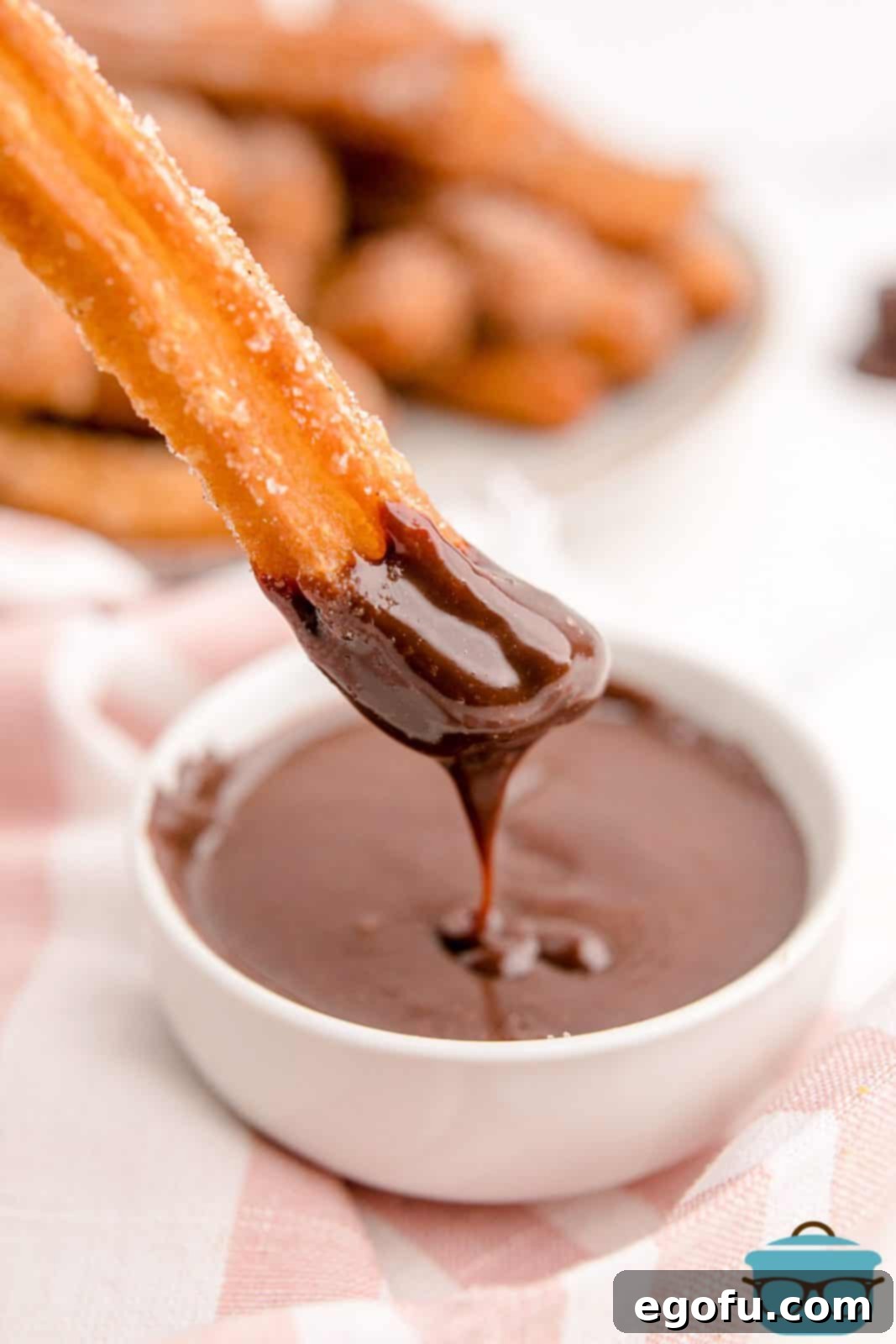
Explore More Sweet Treats
- Easy Baked Churros
- Air Fryer Churro Bites
- Sopapilla Cheesecake Bars
- Cinnamon Sugar Pretzels
- Fry Bread Tacos
- Strawberry Jelly Filled Biscuit Donuts

Homemade Churros (+Video)
A fun and tasty Mexican treat, these Homemade Churros are quick to put together, are so delicious and make the perfect snack or dessert!
Rated 5 out of 5 stars by 10 reviewers.
Prep Time: 20 minutes
Cook Time: 20 minutes
Total Time: 40 minutes
Servings: 16
Author: Brandie Skibinski
Ingredients
For the coating:
- ½ cup granulated sugar
- 1 Tablespoon cinnamon
For the churros:
- 1 cup water
- 2 Tablespoons granulated sugar
- ½ teaspoon salt
- 5 Tablespoons salted butter
- 1 teaspoon vanilla extract
- 1 cup all-purpose flour
- 1 egg
- 4-6 cups vegetable oil for frying
Optional Dips:
- Caramel and/or chocolate sauce
Instructions
In a small bowl, whisk together ½ cup granulated sugar and 1 Tablespoon cinnamon in a medium-sized casserole dish. Set this aside. You’ll use this for coating the churros later.

To make the batter: Add 1 cup water, 2 Tablespoons granulated sugar, ½ teaspoon salt and 5 Tablespoons salted butter into a large saucepan over medium-high heat. Bring to a boil. Turn off the heat then stir in 1 teaspoon vanilla extract.

Then stir in 1 cup all-purpose flour. You will need to stir this for a minute or so, until it is smooth and thickened. It will start to pull away from the pan and almost look like play dough.

Transfer the thickened batter to a large bowl and allow it to cool for at least 10 minutes.
Once the churro batter has cooled some, use a hand mixer to beat 1 egg into the batter until well combined.

While the batter is cooling, pour 4-6 cups vegetable oil for frying into a large pot to use for deep frying. You want the oil to be about 2 inches deep.
I highly recommend starting your oil on medium heat and using a candy thermometer to check the temperature to make sure it heats to around 350 – 360 degrees fahrenheit. This is important because if the oil gets too hot, you will quickly fry the outside of the churro but the inside will not cook fully and you will end up with a burnt outside and gooey, undercooked middle.

Place a paper towel on a plate next to the pot for draining the churros later.
Place the churro dough into a piping bag with a star or flower tip. This batter is VERY thick. You must use a sturdy piping bag – see my notes below.

Pipe churros into 4-5 inch long ropes, directly into the hot oil, using scissors to cut the batter. Don’t overfill the pot or they won’t cook evenly – work in batches. I find it helps if you have someone helping with this part if possible.

It should take about 5 minutes to fully cook. Turn them once during cooking to make sure both sides get browned evenly.

Immediately as you remove each churro from the oil, roll it quickly on the paper towel. Then place it into the cinnamon-sugar mixture, toss to coat, and place it on a cooling rack.

Continue with the rest of the churros. Serve immediately with caramel and/or chocolate sauce.

Notes
- Please refer to my FAQ’s (Frequently Asked Questions) for the answers to the most common questions.
- Important note: You need to have a sturdy piping bag for this. I don’t recommend using a plastic baggie or thin disposable piping bags. The batter is almost the consistency of play dough, it’s very thick so it will easily bust a thin piping bag when trying to push the batter through the piping tip. A reusable, silicone piping bag is really best (I learned that the hard way!)
- Please note: the video text is wrong. You need to allow the pastry batter to cool BEFORE adding the egg.
- You can easily double this recipe to have more on hand or keep for later.
- These can be frozen, see my tips on how to do that.
- Use a candy thermometer to make sure that you maintain a consistent temperature. Or use an electric fryer.
Course: Dessert, Snack
Cuisine: American, Mexican
Nutrition
Calories: 96kcal | Carbohydrates: 14g | Protein: 1g | Fat: 4g | Sodium: 106mg | Fiber: 1g | Sugar: 8g
Nutritional Disclaimer
“The Country Cook” is not a dietician or nutritionist, and any nutritional information shared is an estimate. If calorie count and other nutritional values are important to you, we recommend running the ingredients through whichever online nutritional calculator you prefer. Calories and other nutritional values can vary quite a bit depending on which brands were used.
Did you make this recipe? Share it on Instagram @thecountrycook and mention us #thecountrycook!

